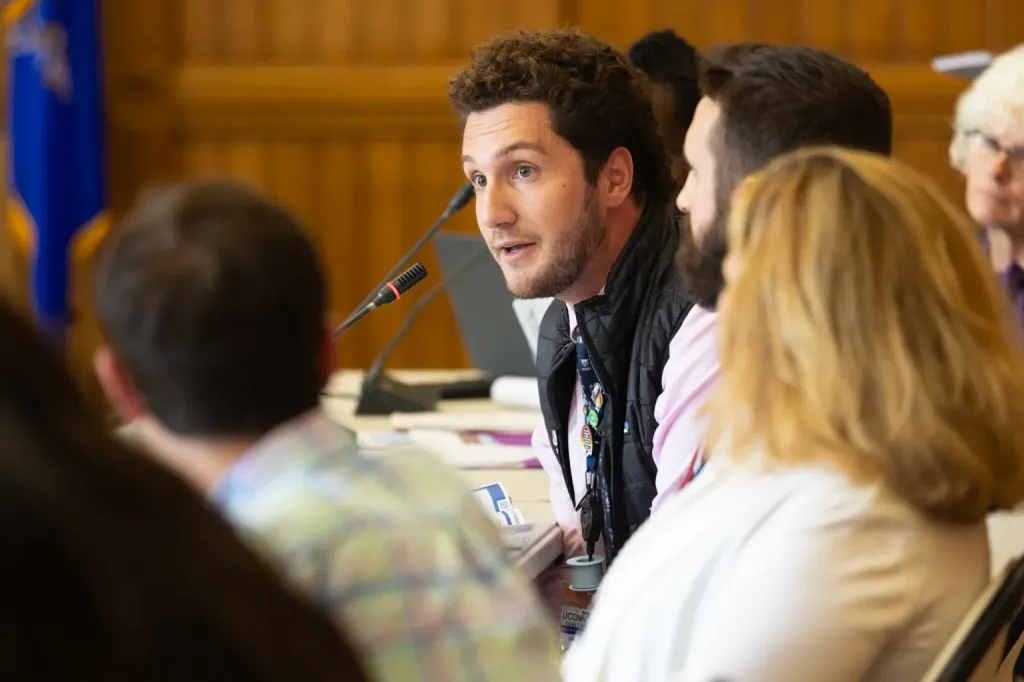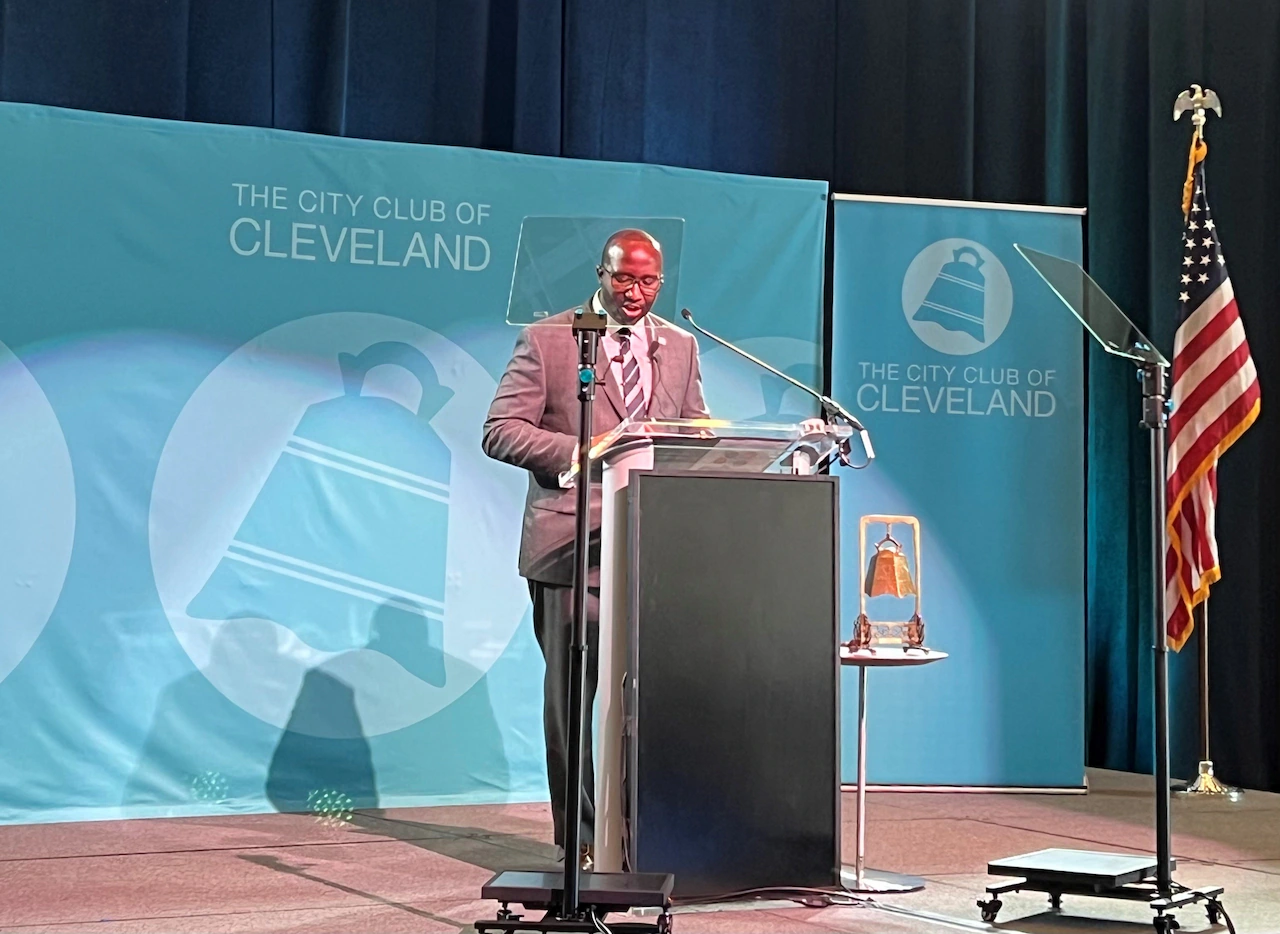
Greg Jackson, a history teacher for New Haven Public Schools, remembers coming home from class at community college in Orange County, New York, in 1993 to find a $3,000 bill waiting for him.
He said he recalls asking his parents, “How are we going to pay for this?”
Their response: “We? You.”
Jackson is one of 518,500 Connecticut residents who have a total of $19.1 billion in student loan debt, according to data analyzed by the Education Data Initiative. The average student loan debt in Connecticut is about $36,800, with about one quarter of borrowers owing between $20,000 and $40,000, Education Data Initiative reports.
Jackson owes $188,000. During the Biden administration, he was enrolled in the SAVE program, an income-based repayment plan that lowered the monthly payment amounts of many borrowers, and under which the federal government would take responsibility for interest payments that borrowers couldn’t pay.
Jackson was paying just $36 a month. And as someone who worked in public service, he was eligible for loan forgiveness after 10 years of payments.
But then the SAVE program became the subject of a court challenge from a group of Republican states that claimed that the program overreached in the amount of student loan forgiveness it allowed. Jackson, along with millions of other borrowers, had their loans placed into administrative forbearance in July 2024, meaning their payments were temporarily paused. Their loans began accruing interest again this past August.
Borrowers across the country, like Jackson, are facing significant changes in how they will have to pay for their college loans.
The One Big Beautiful Bill Act passed by Congress in July will consolidate the current seven repayment plans into two: a standard plan, which requires a fixed monthly payment for between 10 and 25 years based on the size of the loan, and the Repayment Assistance Plan, which bases the monthly payment on the borrower’s income.
Cristher Estrada-Perez, executive director of the Student Loan Fund of New Haven, said the changes would keep people in debt far longer than they needed to be. She said the loss of three of the four repayment plans that are based on income will leave borrowers with fewer options.
Estrada-Perez said that under the SAVE Program, someone making between $50,000 and $60,000 annually would pay $62 a month in student loan payments. With the new Repayment Assistance Plan, that would rise to $167 a month. For someone on the same plan but making between $70,000 to $80,000 annually, payments would rise from $187 to $467 monthly.
Jackson’s new monthly payment, once he transfers into the new Repayment Assistance Plan, will be $240, nearly seven times what he’d been paying. That will limit his ability to save for retirement and to help his daughter pay for college, he said.
Jackson said he has been working with a consultant who told him he’d be eligible for loan forgiveness after 19 more payments — which, he said, is better than having to pay the full amount.
Jackson was a first-generation college student and he didn’t know anything about student loans. He worked throughout his time at college, including three jobs during the summers. While getting his master’s degree at SUNY Albany, he worked overnight shifts in hospitality and as a substitute teacher at Albany High School.
After earning a master’s degree in history, he worked for three years at a high school in the Bronx. He then went back to school on a full scholarship to Stony Brook University for his Ph.D. But even with the scholarship, Jackson had to take out loans to afford to live. Now he wonders if it was worth it.
Jackson has been teaching in New Haven Public Schools since 2023, and he said while he loves teaching, he sometimes questions his decision to seek a doctorate decree.
“It’s just like I have three letters out at the end of my name that cost me a ton of money,” he said. “And as a high school teacher, my students don’t understand what it means. And it really doesn’t mean anything.”
Borrowing caps
In addition to changes to loan repayment programs, the federal budget bill capped the amount that parents and graduate students can borrow through certain federal loan programs.
Under the new system, Parent PLUS loans will be capped at $20,000 annually and $65,000 total per child. Previously, there was no limit to the amount parents could borrow.
Michelle Jarvis-Lettman, Connecticut’s Student Loan Ombuds, said the new limits would be hard on low-income students.
“ It was a great resource for those families to have … even though the interest rate was significantly high,” Jarvis-Lettman said. “Limiting the dollar amount that can be borrowed per year and then the lifetime limit per student — especially in a state like Connecticut, where the costs are significantly higher for higher education — is really going to change what students are going to be able to do and where they’re going to be able to attend.”
Andrew Gillen, a research fellow at the Cato Institute’s Center for Educational Freedom, said many people who were taking out Parent PLUS loans couldn’t afford to pay them back. He said there were other avenues that parents could take, like a home equity line of credit, that may have offered better interest rates. The interest rate for Parent PLUS loans in July 2025 was nearly 9%.
“If we saw a private company doing this, we’d label it predatory lending,” he said.
Under the new legislation, a loan program for graduate students known as Grad PLUS will be eliminated in 2026. Graduate students who take out direct loans will have their loans capped at $20,500 annually or a total of $100,000, with the exception of loans for specialty degree programs in medicine, law and dentistry, which will have a total cap of $200,000.
Estrada-Perez said this, too, would be particularly harmful for students who come from low-income backgrounds, as well as being shortsighted, given Connecticut has experienced a shortage of primary care doctors, particularly in rural areas, and of specialty doctors and nurses.
“It is disastrous,” said Estrada-Perez. “On a moral level, it is basically saying, ‘If you do not have money, you should not go to higher ed.’”
But Gillen and Preston Cooper, a senior fellow at the American Enterprise Institute, said there was evidence that allowing greater student borrowing has driven up tuition rates at some schools.
Gillen and Cooper referenced a 2023 working paper from the National Bureau of Economic Research, which found that the establishment of the Graduate PLUS loans in 2006 increased student loan debt but did not raise access to graduate programs for people from underrepresented backgrounds. The study also found that programs with more access to Graduate PLUS loans were more likely to increase their cost of attendance.
Gillen said that caps would eliminate graduate programs that ultimately didn’t justify the expense of taking out loans. Programs that were worthwhile, he said, would continue to see student investment.
Cooper added that most students were borrowing below the caps that the new law sets. In his own analysis, Gillen found that half of the Graduate PLUS loan disbursements in 2023-24 went to 75 institutions.
He said that students could avail themselves of more affordable public universities, where few students were borrowing above those caps.
But Jarvis-Lettman, Connecticut’s student loans ombuds, noted that tuition covers the cost of the faculty and staff required to run high-end institutions, along with funding the research these schools produce. She said she feared the loan limits would simply make it so that only wealthy students could afford to attend the higher-priced colleges and universities.
Estrada-Perez argued that the loan limits wouldn’t limit the cost of public colleges and universities. Instead, she said, the caps would force colleges and universities to either close down or cut programs.
Some research points to an ongoing decline in state funding for public universities as a contributor to the rise of student loan debt, as colleges have increased tuition rates to make up for the shortfalls. A 2022 report from the National Education Association found that 32 states were spending less on higher education in 2020 than they had in 2008. That report found that Connecticut’s investment in higher education decreased by about $1,500 per student during those years.
Data from the Integrated Postsecondary Education Data System found that the University of Connecticut receives 37% of its funding from the state — one of the highest percentages across the nation. Yet both UConn and Connecticut State Colleges and Universities have claimed significant budget deficits in the last few years. According to a 2023 article in CT Insider, state funding for UConn dropped from 50% of the university’s budget in 1991 to 26% in 2023, although the actual amount in inflation-adjusted dollars remained relatively high.
Chris Collibee, spokesperson for the state Office of Policy and Management, told the Connecticut Mirror that UConn and CSCU are responsible for controlling costs and limiting tuition growth. “We have worked closely with both institutions to encourage them to find efficiencies that reduce cost burdens on students and provide them with the skills Connecticut employers desire,” Collibee said.
Samantha Norton, spokesperson for CSCU, said that state programs like the Mary Ann Handley Award, which provides debt-free community college to students in Connecticut, have helped with affordability, but she added that “sustained investment is essential to ensuring our institutions remain affordable and accessible for all.”
Concerns in Connecticut
University administrators in Connecticut are worried. According to a recent research presentation provided to the legislature’s Higher Education Committee by Nathan Fuerst, UConn’s Vice President for Student Life and Enrollment, and Mona Lucas, Assistant Vice President for Enrollment, parents of about 3,000 UConn students were borrowing through Parent PLUS loans in 2024-25, with an average loan of $20,417 — just over the $20,000 cap the federal government is implementing.
But of those 3,000, about half had taken out loans that were more than $20,000. The average loan amount of those 1,500 borrowers was $35,000.
Rhona Free, president of the University of Saint Joseph, said during a meeting of the legislature’s Higher Education and Employment Advancement Committee earlier this month that her students come out of school with an average of $27,000 in debt. But she said they are hired for good jobs, and their loan default rate, 3.4%, is about a third of the national rate.
“I would argue these are not students who are disillusioned with their higher ed experience, but, again, many of the students or their parents do need to borrow,” Free said.
Free noted that the average Parent PLUS loan for students at SJU was about $22,000 — slightly above the $20,000 annual cap created by the federal government.
Students at Connecticut colleges said during a roundtable in Hartford last week that they’d been raised believing that college was the best option for them to lead a successful life, but the cost of paying back college loans was overwhelming.
Madison Sztaba, a UConn student getting her master’s degree in public administration, said she did everything she could to limit the amount of debt she had to take out. She took Early College Experience classes in high school for college credit, allowing her to graduate with a bachelor’s degree in three years. She lived at home with her parents in Torrington and worked 40 hours a week while taking 21 credits to graduate.
“What’s the balance of being fiscally responsible and being responsible for your health and mental well-being?” said Sztaba. “I shouldn’t have to feel so burnt out about trying to pay for school and at the same time working a job and eventually trying to gain all of this experience to enter the workforce.”
Sztaba said she took out $19,000 in loans, but at a 7% interest rate, which she said has continued to accumulate.
For Nikolas DeAngelo, a senior at Trinity College, going to college was something his parents insisted on. A first-generation college student whose father works as an electrician, DeAngelo was expected to attend college to become an engineer. He ended up switching to an economics major.
DeAngelo said most of his loans are private, at an 18% interest rate, along with some federal loans. He said he will graduate with over $100,000 in debt, despite receiving a large need-based financial aid package from the school.
Trinity College Dean of Admissions and Financial Aid Matthew Hyde said in a statement to CT Mirror that Trinity College has a “robust financial aid program” that “empowers it to meet the full demonstrated financial need for all of its students.” He said the program offers both need-based aid and merit scholarships.
“As compared to many in the larger higher education marketplace, Trinity is less reliant on federal support for student aid in general. However, the recent changes add an unfortunate layer of difficulty for some students. Nearly 100 Trinity families participate in Parent PLUS program, and the average amount is nearly double the new cap,” Hyde said.
High demand for professionals
At an August meeting of the Board of Regents, Zulma Toro, the president of Central Connecticut State University, estimated that the loan caps could cost the university up to $10 million each year. She anticipated that the hardest-hit program would be the Doctor of Nurse Anesthesia Practice, which currently has 87 students enrolled.
“ It’s ironic, because there is a very high demand for those professionals, but we are sure, according to the analysis we have conducted, that a significant number of those students will not be able to afford the program,” Toro said at the meeting.
The DNAP program takes three years to complete, and students cannot work during the program because of its intense clinical requirements, Toro said.
Rachel Rachler, Chair of the Department of Nurse Anesthesia Practice at Central, said her students often come into the program with families and outside responsibilities. She said they take out Graduate PLUS loans — an average of $43,000 over three years — just to cover the cost of living.
But that’s not all. According to Rachler, with the cost of tuition, fees and basic living expenses, the three-year program can run anywhere from $150,000 to $173,000. The new federal loan caps will limit lifetime borrowing to $100,000.
Rachler said she doesn’t believe the loan limits will cause her program to lower its tuition. The program has expensive equipment and textbooks, and Central has to pay professionals in the field to work as faculty members. More likely, she said, the new loan limits will just affect enrollment. Like Toro, she noted that there is a shortage of anesthesia providers in the state.
Stephanie Reitz, spokesperson for the University of Connecticut, said that 572 graduate students at UConn borrowed through the Grad PLUS program in 2024-25. More than 200 of those were studying either medicine or law.
Asked if UConn officials were concerned that the new caps on federal loans could have a negative effect on the university’s doctoral program, Reitz said the university did not want to make “broad speculations.” She added that UConn’s programs “continue to generate strong enrollment and post-graduation outcomes” and that the school is the top producer of doctors, attorneys and dentists in the state.
The average amounts borrowed for each of UConn’s five graduate programs with the highest number of Graduate PLUS loan borrowers — law, medical, dental, social work and physical therapy — did not exceed the annual $20,000 limit that the federal government plans to impose, according to the data Reitz provided.
At the roundtable last week, Fabio Saccomanno, a second-year medical student at UConn’s School of Medicine, said he expects to graduate from medical school with more than $300,000 in debt.
Saccomanno said he spent the summer working in Hartford with underserved populations. He said that while many of his classmates want to serve people in need, the amount of debt they have has driven them to look for more lucrative medical specialties, rather than going into primary care.
State Comptroller Sean Scanlon said Connecticut needs to do more to attract and keep doctors in the state. He cited a program in Maine, which will waive student loan debt for medical professionals who practice in the state for five years.
Josh Hurlock, deputy director for the Connecticut Higher Education Student Loan Authority, or CHESLA, said the agency was considering ways to bridge the gaps that the federal changes had created. He said his agency is looking at the creation of a replacement for the Grad PLUS loan, as well as the possibility of administering a loan program backed by state dollars that would make loan programs more accessible to students who might not qualify.
The state also runs a program through the Office of Higher Education that allows Connecticut residents who have lived in the state for five years, graduated from a Connecticut university and completed 50 hours of volunteer service to receive up to $5,000 annually and $20,000 over four years in loan reimbursements. Tim Larson, Commissioner of the Office of Higher Education, said that the program has already paid $1.4 million to 558 students. Since applications reopened last month, they have received more than 1,000 applicants.
Jackson, the teacher in New Haven, said he’ll continue to work at New Haven Public Schools — at least until his loans are forgiven.
He said he doesn’t always recommend to his students that they go to college. He said he remembers watching students at Western — unsure of what they wanted to do, and unprepared for the academic and social requirements of college — end up dropping out saddled with student loans.
“I just want them to … be able to provide for themselves and have health care. That’s really, to me, the most important thing,” said Jackson. “Statistically, when you have a college education, you do better. But I’m not certain that’s in the cards for everyone anymore. And my students specifically are the lowest economic status.”



